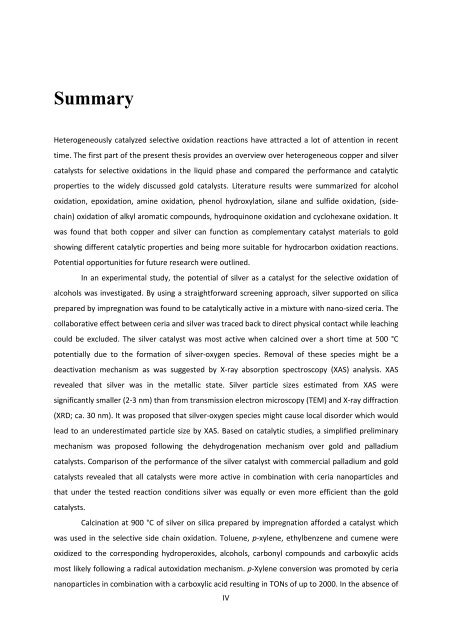Heterogeneously Catalyzed Oxidation Reactions Using ... - CHEC
Heterogeneously Catalyzed Oxidation Reactions Using ... - CHEC
Heterogeneously Catalyzed Oxidation Reactions Using ... - CHEC
You also want an ePaper? Increase the reach of your titles
YUMPU automatically turns print PDFs into web optimized ePapers that Google loves.
Summary<br />
<strong>Heterogeneously</strong> catalyzed selective oxidation reactions have attracted a lot of attention in recent<br />
time. The first part of the present thesis provides an overview over heterogeneous copper and silver<br />
catalysts for selective oxidations in the liquid phase and compared the performance and catalytic<br />
properties to the widely discussed gold catalysts. Literature results were summarized for alcohol<br />
oxidation, epoxidation, amine oxidation, phenol hydroxylation, silane and sulfide oxidation, (side‐<br />
chain) oxidation of alkyl aromatic compounds, hydroquinone oxidation and cyclohexane oxidation. It<br />
was found that both copper and silver can function as complementary catalyst materials to gold<br />
showing different catalytic properties and being more suitable for hydrocarbon oxidation reactions.<br />
Potential opportunities for future research were outlined.<br />
In an experimental study, the potential of silver as a catalyst for the selective oxidation of<br />
alcohols was investigated. By using a straightforward screening approach, silver supported on silica<br />
prepared by impregnation was found to be catalytically active in a mixture with nano‐sized ceria. The<br />
collaborative effect between ceria and silver was traced back to direct physical contact while leaching<br />
could be excluded. The silver catalyst was most active when calcined over a short time at 500 °C<br />
potentially due to the formation of silver‐oxygen species. Removal of these species might be a<br />
deactivation mechanism as was suggested by X‐ray absorption spectroscopy (XAS) analysis. XAS<br />
revealed that silver was in the metallic state. Silver particle sizes estimated from XAS were<br />
significantly smaller (2‐3 nm) than from transmission electron microscopy (TEM) and X‐ray diffraction<br />
(XRD; ca. 30 nm). It was proposed that silver‐oxygen species might cause local disorder which would<br />
lead to an underestimated particle size by XAS. Based on catalytic studies, a simplified preliminary<br />
mechanism was proposed following the dehydrogenation mechanism over gold and palladium<br />
catalysts. Comparison of the performance of the silver catalyst with commercial palladium and gold<br />
catalysts revealed that all catalysts were more active in combination with ceria nanoparticles and<br />
that under the tested reaction conditions silver was equally or even more efficient than the gold<br />
catalysts.<br />
Calcination at 900 °C of silver on silica prepared by impregnation afforded a catalyst which<br />
was used in the selective side chain oxidation. Toluene, p‐xylene, ethylbenzene and cumene were<br />
oxidized to the corresponding hydroperoxides, alcohols, carbonyl compounds and carboxylic acids<br />
most likely following a radical autoxidation mechanism. p‐Xylene conversion was promoted by ceria<br />
nanoparticles in combination with a carboxylic acid resulting in TONs of up to 2000. In the absence of<br />
IV



